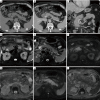Diffusion-weighted MRI: new paradigm for the diagnosis of interstitial oedematous pancreatitis
- PMID: 31183329
- PMCID: PMC6534761
- DOI: 10.21037/gs.2018.12.08
Diffusion-weighted MRI: new paradigm for the diagnosis of interstitial oedematous pancreatitis
Conflict of interest statement
Conflicts of Interest: The authors have no conflicts of interest to declare.
Figures






Similar articles
-
Magnetic resonance imaging in detecting acute oedematous and haemorrhagic pancreatitis: an experimental study in pigs.Eur Surg Res. 1989;21(1):25-33. doi: 10.1159/000129000. Eur Surg Res. 1989. PMID: 2714307
-
Focal pancreatitis mimicking pancreatic mass: magnetic resonance imaging (MRI)/magnetic resonance cholangiopancreatography (MRCP) findings including diffusion-weighted MRI.Acta Radiol. 2008 Jun;49(5):490-7. doi: 10.1080/02841850802014602. Acta Radiol. 2008. PMID: 18568532
-
Contrast-enhanced magnetic resonance imaging for the detection of acute haemorrhagic necrotizing pancreatitis.Eur Radiol. 1997;7(1):17-20. doi: 10.1007/s003300050100. Eur Radiol. 1997. PMID: 9000388
-
[The clinical application of diffusion weighted magnetic resonance imaging to acute cerebrovascular disorders].No To Shinkei. 1998 Sep;50(9):787-95. No To Shinkei. 1998. PMID: 9789301 Review. Japanese.
-
Imaging lexicon for acute pancreatitis: 2012 Atlanta Classification revisited.Gastroenterol Rep (Oxf). 2016 Feb;4(1):16-23. doi: 10.1093/gastro/gov036. Epub 2015 Jul 29. Gastroenterol Rep (Oxf). 2016. PMID: 26224684 Free PMC article. Review.
Cited by
-
Diffusion-weighted Imaging: New Paradigm in Diagnosis of Early Acute Pancreatitis.Ann Afr Med. 2024 Oct 1;23(4):635-640. doi: 10.4103/aam.aam_79_24. Epub 2024 Aug 13. Ann Afr Med. 2024. PMID: 39138974 Free PMC article.
-
Magnetic resonance severity index assessed by T1-weighted imaging for acute pancreatitis: correlation with clinical outcomes and grading of the revised Atlanta classification-a narrative review.Gland Surg. 2020 Dec;9(6):2312-2320. doi: 10.21037/gs-20-554. Gland Surg. 2020. PMID: 33447582 Free PMC article. Review.
References
Publication types
LinkOut - more resources
Full Text Sources
